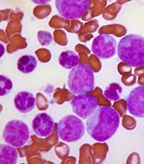Chronic Fatigue Limits Quality of Life in Imatinib-Treated CML Patients
A study of patients with chronic myeloid leukemia treated with imatinib found that chronic fatigue is the major factor that limits health-related quality of life.
A study of patients with chronic myeloid leukemia (CML) treated with imatinib found that chronic fatigue is the major factor that limits health-related quality of life (HRQOL).

Blast crisis of CML: Peripheral blood smear revealing the histopathologic features indicative of a blast crisis in the case of CML
HRQOL has become substantially more important in the treatment of CML, as 5-year survival rates have climbed dramatically with the use of tyrosine kinase inhibitors, such as imatinib. Factors associated with HRQOL, though, have not been clearly studied. “Such information would have important clinical implications, for example, to lay the groundwork for developing targeted supportive care programs for CML survivors,” wrote study authors led by Fabio Efficace, PhD, of the Italian Group for Adult Hematologic Diseases in Rome. The new study was published online ahead of print on March 15 in Leukemia.
The researchers analyzed data on 422 CML patients (out of 448 eligible patients enrolled) at 26 centers, all of whom were treated with imatinib; the median treatment time was 5 years. HRQOL was assessed using the Medical Outcomes Study 36-Item Short-Form Health Survey (SF-36), and fatigue was evaluated using the Functional Assessment of Chronic Illness Therapy (FACIT)-Fatigue scale.
Multivariate analysis showed that several factors were associated with better physical functioning, including younger age, male gender, higher education, and less fatigue (P < .010). Fatigue was the only such factor, however, that showed a significant association with all of the physically related scales of the SF-36.
Less fatigue was also associated with better social functioning, along with older age and greater social support (P < .01). Again, fatigue was correlated with better functioning on all scales of the SF-36.
Chronic fatigue did not generally appear as a standalone symptom. For example, patients in the higher fatigue category also commonly (60%) reported severe musculoskeletal pain, while only 4% of those with low fatigue reported that symptom. “This pattern was consistent across all treatment-related symptoms investigated,” the authors wrote. Correlation analysis showed that musculoskeletal pain (r = 0.511; P < .001) and muscular cramps (r = 0.448; P < .001) were the most highly correlated symptoms with fatigue.
The authors noted that the magnitude of differences between patients with high vs low fatigue levels was very large. “Fatigue greatly impacted on the extent to which the physical health and the emotional problems limited the work or other usual activities of patients in terms of time and performance,” the researchers wrote. “Future therapeutic strategies, tailored on the individual patient characteristics, could be crucial in reducing chronic fatigue and ultimately improve HRQOL outcomes.”